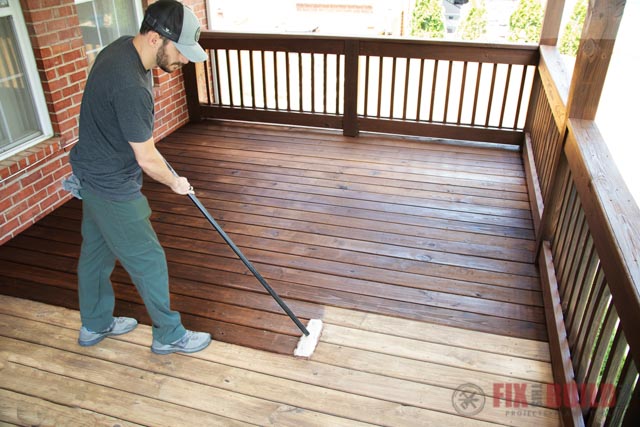Stain Deck for a Durable Complete: Tips and Techniques
A Comprehensive Overview to Different Kinds of Deck Discoloration Techniques for Ultimate Defense and Aesthetic Appeals
In the realm of deck upkeep, the art of discoloring stands as a critical step towards both preserving the stability of your outside space and boosting its visual allure. As we navigate through the detailed world of deck staining methods, one begins to value the nuanced techniques that can make all the distinction in between a sub-par coating and a flawless one.
Recognizing Different Kinds of Discolorations
Different kinds of discolorations are frequently utilized in the procedure of deck discoloration to achieve different aesthetic and safety results. On the other hand, semi-transparent spots use an equilibrium in between color enhancement and protection, enabling some timber grain to reveal through.
Toners add a hint of color to the timber while giving marginal security, making them suitable for newer decks with less wear. Comprehending the features and benefits of each type of stain is important for achieving the desired appearance and durability for your deck.
Picking the Right Discoloration Shade
When thinking about the visual appeals of your deck discoloration task, the option of stain shade plays an important function in boosting the protective qualities of the picked discolor kind (Stain Deck). The shade you select can considerably influence the general look of your deck, in addition to its capacity to stand up to the aspects over time
When choosing a stain shade, it's important to consider the existing color system of your home's exterior. Integrating the deck stain with the total aesthetic of your home can create a visually attractive and natural outdoor room. In addition, the color of your deck stain can influence the temperature level of the deck surface; darker shades tend to soak up more warm, while lighter shades reflect sunlight and remain cooler.
Moreover, the sort of wood you are discoloring will certainly also impact just how the stain color shows up. Different wood types can interact with the stain in different means, potentially changing the last shade. It's recommended to check the tarnish on a small, inconspicuous location of the deck to guarantee the color ends up as preferred before waging the whole task.
Preparing Your Deck for Discoloration
To guarantee a effective and resilient deck staining project, comprehensive prep work of the deck surface area is necessary. Begin by cleaning up the deck completely to eliminate dirt, grime, mold, and any old discolor or complete.
Evaluate the deck for any kind of damaged or rotten boards that need to be replaced. Hammer down any protruding nails and sand any kind of harsh areas to ensure a smooth surface area for discoloration. Check for any kind of loosened railings or actions that might need tightening or fixing.
Once the deck is tidy, dry, and in great repair work, consider using a wood brightener to recover the deck's natural shade and open up the timber pores for better tarnish penetration. Ultimately, safeguard any kind of close-by plants, furnishings, or surfaces with plastic sheet before continuing with the staining process. Appropriate prep work is essential to attaining a professional-looking finish and maximizing the durability of your deck tarnish.
Applying Stain With Different Strategies
For a flawless and expert surface, the method of using discolor plays an essential function in enhancing the appearance and toughness of your deck. There are numerous techniques you can use to make sure a reliable application of stain.
Cleaning is a conventional approach that permits for accuracy and control over the amount of stain applied. It is optimal for intricate areas and reaching between deck boards (Water-Based Stains). Rolling is a quicker choice, covering bigger surface areas successfully. Nevertheless, back-brushing after rolling is recommended to also out the discolor and function it into the wood for much better infiltration.
Spraying is another prominent strategy, providing rate and ease of application, particularly for large deck locations. Whichever technique you choose, guaranteeing proper prep work and following manufacturer standards will certainly assist attain a durable and attractive discolor coating on your deck.

Maintaining and Re-staining Your Deck
Proper upkeep and prompt re-staining are crucial for preserving the appeal and durability of your deck. Routine upkeep tasks include sweeping off debris, cleaning up with a deck cleaner, and evaluating for any indications of wear or damages. Dealing with issues quickly can avoid much more considerable problems in the future. When it concerns re-staining your deck, the frequency relies on different factors such as the sort of stain used, the climate in your area, and just how much damage your deck experiences. Generally, it is recommended to re-stain your deck every 2-4 years to preserve its security and visual appeals.
Prior to re-staining, guarantee the deck is tidy, completely Get More Info dry, and devoid of any type of previous stain residue. Fining sand might be necessary to smooth out rough areas or remove old discolor that is flaking. Choose a top quality tarnish that matches your deck's product and provides the wanted degree of protection. Use the discolor uniformly making use of the proper technique reviewed earlier in this overview to guarantee a stunning and durable surface - Right Deck Stain. By remaining aggressive with maintenance and re-staining, you can enjoy a well-protected and visually enticing deck for several years to find.
Final Thought
Finally, recognizing the various kinds of deck spots, choosing the appropriate shade, appropriately preparing the deck, applying discolor with different strategies, and re-staining the deck and maintaining are vital actions for supreme protection and aesthetics. By complying with these actions, you can make sure that your deck continues to be in leading problem for several years to find.
Furthermore, the color of your deck tarnish can influence the temperature level of the deck surface area; darker colors often tend to soak up even more warmth, while lighter colors mirror sunlight and stay cooler.
It's advisable to test the tarnish on a tiny, inconspicuous location of the deck to make sure the shade turns out as desired before proceeding with the whole job.
